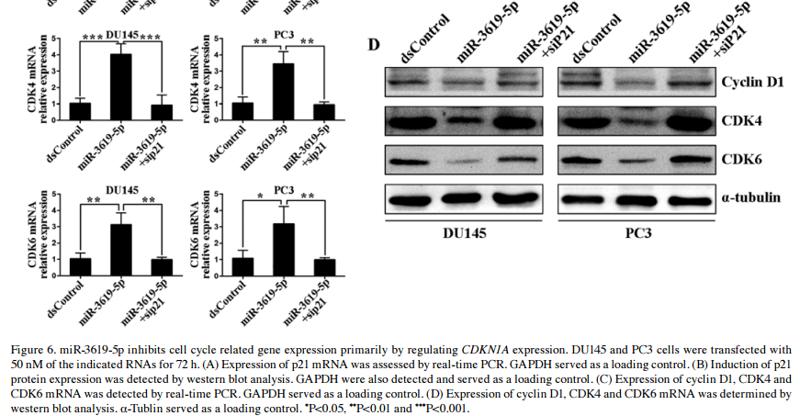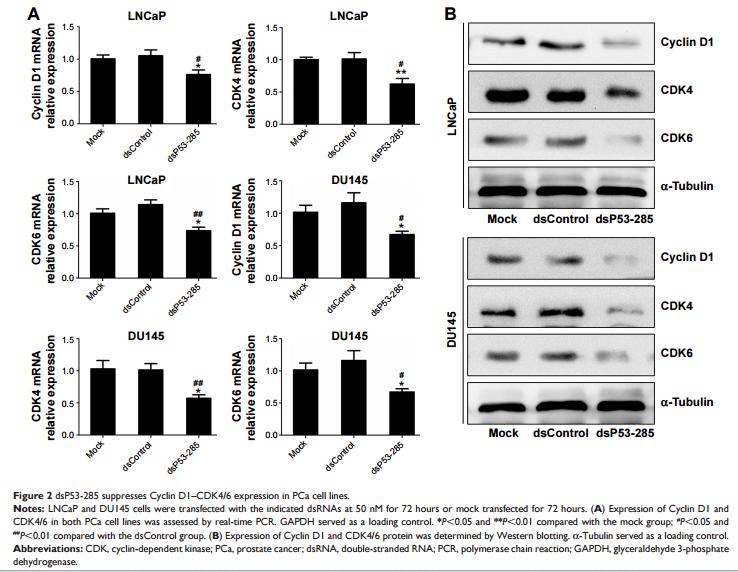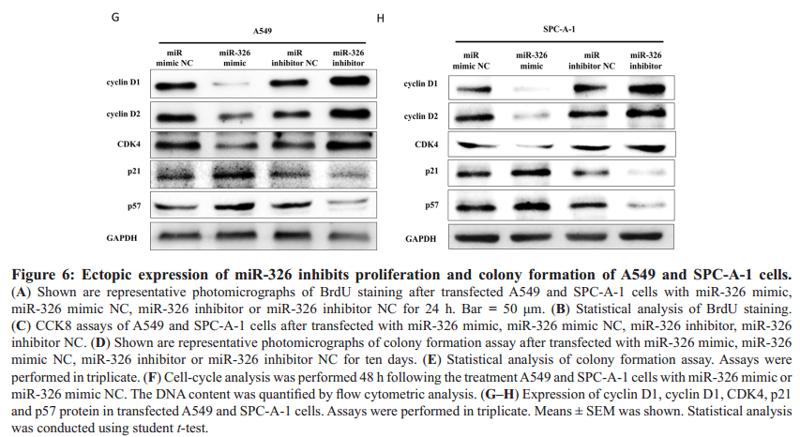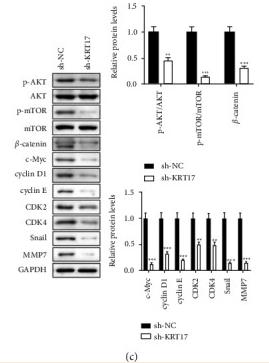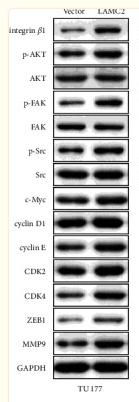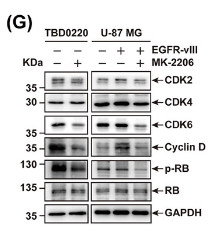| 产品: | CDK4 抗体 |
| 货号: | DF6102 |
| 描述: | Rabbit polyclonal antibody to CDK4 |
| 应用: | WB IHC |
| 文献验证: | WB |
| 反应: | Human, Mouse, Rat |
| 预测: | Pig, Zebrafish, Bovine, Horse, Sheep, Rabbit, Dog, Xenopus |
| 分子量: | 34kDa; 34kD(Calculated). |
| 蛋白号: | P11802 |
| RRID: | AB_2838070 |
产品描述
*The optimal dilutions should be determined by the end user.
*Tips:
WB: 适用于变性蛋白样本的免疫印迹检测. IHC: 适用于组织样本的石蜡(IHC-p)或冰冻(IHC-f)切片样本的免疫组化/荧光检测. IF/ICC: 适用于细胞样本的荧光检测. ELISA(peptide): 适用于抗原肽的ELISA检测.
引用格式: Affinity Biosciences Cat# DF6102, RRID:AB_2838070.
展开/折叠
Cdk 4; cdk4; CDK4 protein; CDK4_HUMAN; Cell division kinase 4; Cell division protein kinase 4; CMM 3; CMM3; Crk3; Cyclin dependent kinase 4; Cyclin-dependent kinase 4; Melanoma cutaneous malignant 3; MGC14458; p34 cdk4; PSK J3; PSK-J3;
抗原和靶标
- P11802 CDK4_HUMAN:
- Protein BLAST With
- NCBI/
- ExPASy/
- Uniprot
MATSRYEPVAEIGVGAYGTVYKARDPHSGHFVALKSVRVPNGGGGGGGLPISTVREVALLRRLEAFEHPNVVRLMDVCATSRTDREIKVTLVFEHVDQDLRTYLDKAPPPGLPAETIKDLMRQFLRGLDFLHANCIVHRDLKPENILVTSGGTVKLADFGLARIYSYQMALTPVVVTLWYRAPEVLLQSTYATPVDMWSVGCIFAEMFRRKPLFCGNSEADQLGKIFDLIGLPPEDDWPRDVSLPRGAFPPRGPRPVQSVVPEMEESGAQLLLEMLTFNPHKRISAFRALQHSYLHKDEGNPE
种属预测
score>80的预测可信度较高,可尝试用于WB检测。*预测模型主要基于免疫原序列比对,结果仅作参考,不作为质保凭据。
High(score>80) Medium(80>score>50) Low(score<50) No confidence
翻译修饰 - P11802 作为底物
| Site | PTM Type | Enzyme | Source |
|---|---|---|---|
| A2 | Acetylation | Uniprot | |
| Y17 | Phosphorylation | P07948 (LYN) , P07947 (YES1) , P12931 (SRC) | Uniprot |
| K22 | Ubiquitination | Uniprot | |
| K35 | Ubiquitination | Uniprot | |
| R101 | Methylation | Uniprot | |
| K106 | Ubiquitination | Uniprot | |
| K118 | Ubiquitination | Uniprot | |
| K142 | Ubiquitination | Uniprot | |
| K155 | Ubiquitination | Uniprot | |
| T172 | Phosphorylation | P50613 (CDK7) | Uniprot |
| T177 | Phosphorylation | Uniprot | |
| K211 | Ubiquitination | Uniprot | |
| T277 | Phosphorylation | Uniprot | |
| K282 | Ubiquitination | Uniprot | |
| K297 | Ubiquitination | Uniprot |
翻译修饰 - P11802 作为激酶
| Substrate | Site | Source |
|---|---|---|
| P04179 (SOD2) | S106 | Uniprot |
| P06400 (RB1) | T5 | Uniprot |
| P06400 (RB1) | S249 | Uniprot |
| P06400 (RB1) | T252 | Uniprot |
| P06400 (RB1) | T356 | Uniprot |
| P06400 (RB1) | T373 | Uniprot |
| P06400 (RB1) | S608 | Uniprot |
| P06400 (RB1) | S612 | Uniprot |
| P06400 (RB1) | S780 | Uniprot |
| P06400 (RB1) | S788 | Uniprot |
| P06400 (RB1) | S795 | Uniprot |
| P06400 (RB1) | S807 | Uniprot |
| P06400 (RB1) | S811 | Uniprot |
| P06400 (RB1) | T826 | Uniprot |
| P06748 (NPM1) | T199 | Uniprot |
| P15923 (TCF3) | S139 | Uniprot |
| P15923 (TCF3) | S245 | Uniprot |
| P17480 (UBTF) | S484 | Uniprot |
| P28749 (RBL1) | T369 | Uniprot |
| P28749 (RBL1) | S640 | Uniprot |
| P28749 (RBL1) | S650 | Uniprot |
| P28749-1 (RBL1) | S964 | Uniprot |
| P28749 (RBL1) | S975 | Uniprot |
| P38398 (BRCA1) | S632 | Uniprot |
| P43694 (GATA4) | S105 | Uniprot |
| P84022-1 (SMAD3) | T8 | Uniprot |
| P84022 (SMAD3) | T179 | Uniprot |
| P84022 (SMAD3) | S204 | Uniprot |
| P84022 (SMAD3) | S208 | Uniprot |
| P84022-1 (SMAD3) | S213 | Uniprot |
| Q06830 (PRDX1) | T90 | Uniprot |
| Q08050 (FOXM1) | S4 | Uniprot |
| Q08050 (FOXM1) | S35 | Uniprot |
| Q08050 (FOXM1) | S451 | Uniprot |
| Q08050 (FOXM1) | S489 | Uniprot |
| Q08050 (FOXM1) | S508 | Uniprot |
| Q08050 (FOXM1) | T510 | Uniprot |
| Q08050 (FOXM1) | S522 | Uniprot |
| Q08050 (FOXM1) | T600 | Uniprot |
| Q08050 (FOXM1) | T611 | Uniprot |
| Q08050 (FOXM1) | T620 | Uniprot |
| Q08050 (FOXM1) | T627 | Uniprot |
| Q08050 (FOXM1) | S704 | Uniprot |
| Q08999 (RBL2) | T401 | Uniprot |
| Q08999 (RBL2) | S672 | Uniprot |
| Q08999 (RBL2) | S1035 | Uniprot |
| Q12778 (FOXO1) | S249 | Uniprot |
| Q13761 (RUNX3) | S356 | Uniprot |
| Q14814 (MEF2D) | S98 | Uniprot |
| Q14814 (MEF2D) | S110 | Uniprot |
| Q8IZL8 (PELP1) | S477 | Uniprot |
| Q8IZL8 (PELP1) | S991 | Uniprot |
| Q92879 (CELF1) | S302 | Uniprot |
| Q96KS0 (EGLN2) | S130 | Uniprot |
| Q9BQA1 (WDR77) | T5 | Uniprot |
| Q9BQA1 (WDR77) | S264 | Uniprot |
| Q9BQA1 (WDR77) | S306 | Uniprot |
| Q9NS23-2 (RASSF1) | S203 | Uniprot |
| Q9NS23 (RASSF1) | S207 | Uniprot |
研究背景
Ser/Thr-kinase component of cyclin D-CDK4 (DC) complexes that phosphorylate and inhibit members of the retinoblastoma (RB) protein family including RB1 and regulate the cell-cycle during G(1)/S transition. Phosphorylation of RB1 allows dissociation of the transcription factor E2F from the RB/E2F complexes and the subsequent transcription of E2F target genes which are responsible for the progression through the G(1) phase. Hypophosphorylates RB1 in early G(1) phase. Cyclin D-CDK4 complexes are major integrators of various mitogenenic and antimitogenic signals. Also phosphorylates SMAD3 in a cell-cycle-dependent manner and represses its transcriptional activity. Component of the ternary complex, cyclin D/CDK4/CDKN1B, required for nuclear translocation and activity of the cyclin D-CDK4 complex.
Phosphorylation at Thr-172 is required for enzymatic activity. Phosphorylated, in vitro, at this site by CCNH-CDK7, but, in vivo, appears to be phosphorylated by a proline-directed kinase. In the cyclin D-CDK4-CDKN1B complex, this phosphorylation and consequent CDK4 enzyme activity, is dependent on the tyrosine phosphorylation state of CDKN1B. Thus, in proliferating cells, CDK4 within the complex is phosphorylated on Thr-172 in the T-loop. In resting cells, phosphorylation on Thr-172 is prevented by the non-tyrosine-phosphorylated form of CDKN1B.
Cytoplasm. Nucleus. Nucleus membrane.
Note: Cytoplasmic when non-complexed. Forms a cyclin D-CDK4 complex in the cytoplasm as cells progress through G(1) phase. The complex accumulates on the nuclear membrane and enters the nucleus on transition from G(1) to S phase. Also present in nucleoli and heterochromatin lumps. Colocalizes with RB1 after release into the nucleus.
Component of the D-CDK4 complex, composed of CDK4 and some D-type G1 cyclin (CCND1, CCND2 or CCND3). Interacts directly in the complex with CCND1, CCND2 or CCND3. Interacts with SEI1 and ZNF655. Forms a ternary complex, cyclin D-CDK4-CDKN1B, involved in modulating CDK4 enzymatic activity. Interacts directly with CDKN1B (phosphorylated on 'Tyr-88' and 'Tyr-89'); the interaction allows assembly of the cyclin D-CDK4 complex, Thr-172 phosphorylation, nuclear translocation and enhances the cyclin D-CDK4 complex activity. CDK4 activity is either inhibited or enhanced depending on stoichiometry of complex. The non-tyrosine-phosphorylated form of CDKN1B prevents T-loop phosphorylation of CDK4 producing inactive CDK4. Interacts (unphosphorylated form) with CDK2. Also forms ternary complexes with CDKN1A or CDKN2A. Interacts directly with CDKN1A (via its N-terminal); the interaction promotes the assembly of the cyclin D-CDK4 complex, its nuclear translocation and promotes the cyclin D-dependent enzyme activity of CDK4. Interacts with CCND1; the interaction is prevented with the binding of CCND1 to INSM1 during cell cycle progression. Probably forms a complex composed of chaperones HSP90 and HSP70, co-chaperones CDC37, PPP5C, TSC1 and client protein TSC2, CDK4, AKT, RAF1 and NR3C1; this complex does not contain co-chaperones STIP1/HOP and PTGES3/p23. Interacts with CEBPA (when phosphorylated). Interacts with FNIP1 and FNIP2.
Belongs to the protein kinase superfamily. CMGC Ser/Thr protein kinase family. CDC2/CDKX subfamily.
研究领域
· Cellular Processes > Cell growth and death > Cell cycle. (View pathway)
· Cellular Processes > Cell growth and death > p53 signaling pathway. (View pathway)
· Cellular Processes > Cell growth and death > Cellular senescence. (View pathway)
· Cellular Processes > Cellular community - eukaryotes > Tight junction. (View pathway)
· Environmental Information Processing > Signal transduction > PI3K-Akt signaling pathway. (View pathway)
· Human Diseases > Drug resistance: Antineoplastic > Endocrine resistance.
· Human Diseases > Infectious diseases: Viral > Hepatitis B.
· Human Diseases > Infectious diseases: Viral > Measles.
· Human Diseases > Infectious diseases: Viral > Human papillomavirus infection.
· Human Diseases > Infectious diseases: Viral > HTLV-I infection.
· Human Diseases > Cancers: Overview > Pathways in cancer. (View pathway)
· Human Diseases > Cancers: Overview > Viral carcinogenesis.
· Human Diseases > Cancers: Specific types > Pancreatic cancer. (View pathway)
· Human Diseases > Cancers: Specific types > Glioma. (View pathway)
· Human Diseases > Cancers: Specific types > Melanoma. (View pathway)
· Human Diseases > Cancers: Specific types > Bladder cancer. (View pathway)
· Human Diseases > Cancers: Specific types > Chronic myeloid leukemia. (View pathway)
· Human Diseases > Cancers: Specific types > Small cell lung cancer. (View pathway)
· Human Diseases > Cancers: Specific types > Non-small cell lung cancer. (View pathway)
· Human Diseases > Cancers: Specific types > Breast cancer. (View pathway)
· Human Diseases > Cancers: Specific types > Hepatocellular carcinoma. (View pathway)
· Organismal Systems > Immune system > T cell receptor signaling pathway. (View pathway)
文献引用
Application: WB Species: Human Sample: TBD0220, U-87 MG, and U-87 MG-EGFR-vIII cells
Application: WB Species: Human Sample: TBD0220 and U87MG cells
Application: WB Species: human Sample: T24 and EJ cells
Application: WB Species: Rat Sample: testicular tissue
Application: WB Species: Human Sample: A375 and SK-MEL-28 cell
Application: WB Species: human Sample:
Application: WB Species: Human Sample: HepG2 cells
限制条款
产品的规格、报价、验证数据请以官网为准,官网链接:www.affbiotech.com | www.affbiotech.cn(简体中文)| www.affbiotech.jp(日本語)产品的数据信息为Affinity所有,未经授权不得收集Affinity官网数据或资料用于商业用途,对抄袭产品数据的行为我们将保留诉诸法律的权利。
产品相关数据会因产品批次、产品检测情况随时调整,如您已订购该产品,请以订购时随货说明书为准,否则请以官网内容为准,官网内容有改动时恕不另行通知。
Affinity保证所销售产品均经过严格质量检测。如您购买的商品在规定时间内出现问题需要售后时,请您在Affinity官方渠道提交售后申请。产品仅供科学研究使用。不用于诊断和治疗。
产品未经授权不得转售。
Affinity Biosciences将不会对在使用我们的产品时可能发生的专利侵权或其他侵权行为负责。Affinity Biosciences, Affinity Biosciences标志和所有其他商标所有权归Affinity Biosciences LTD.

